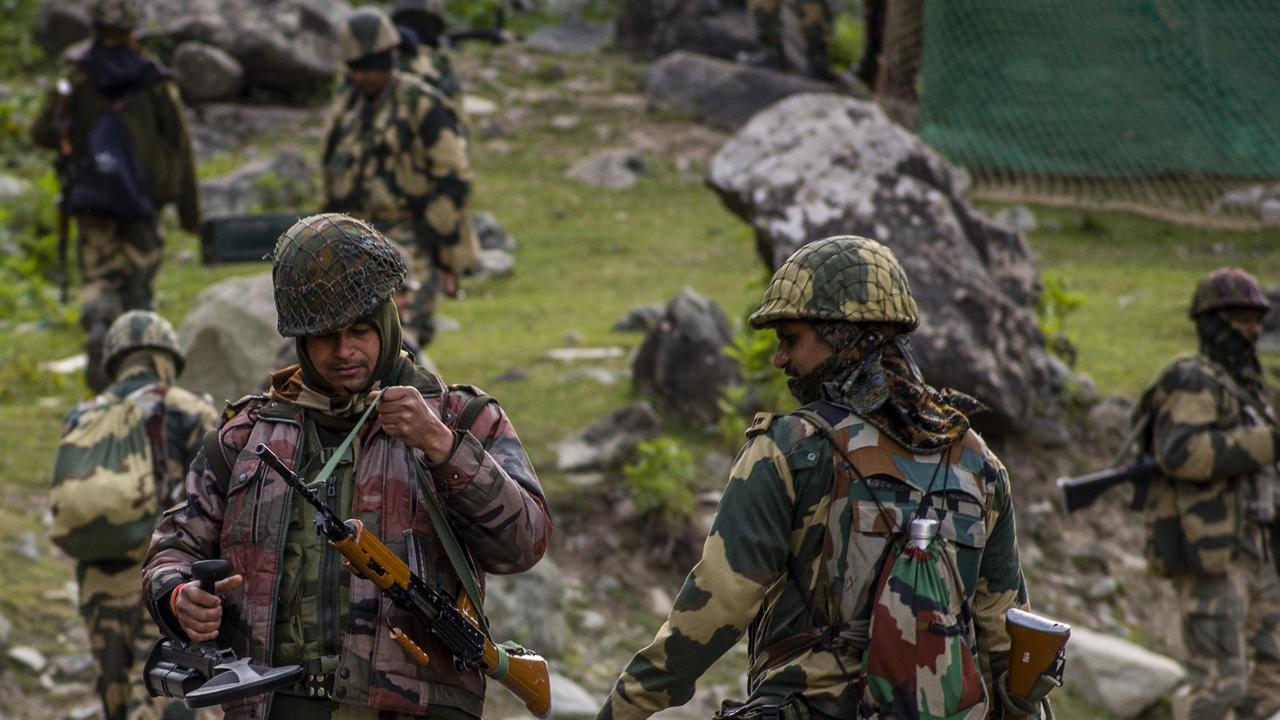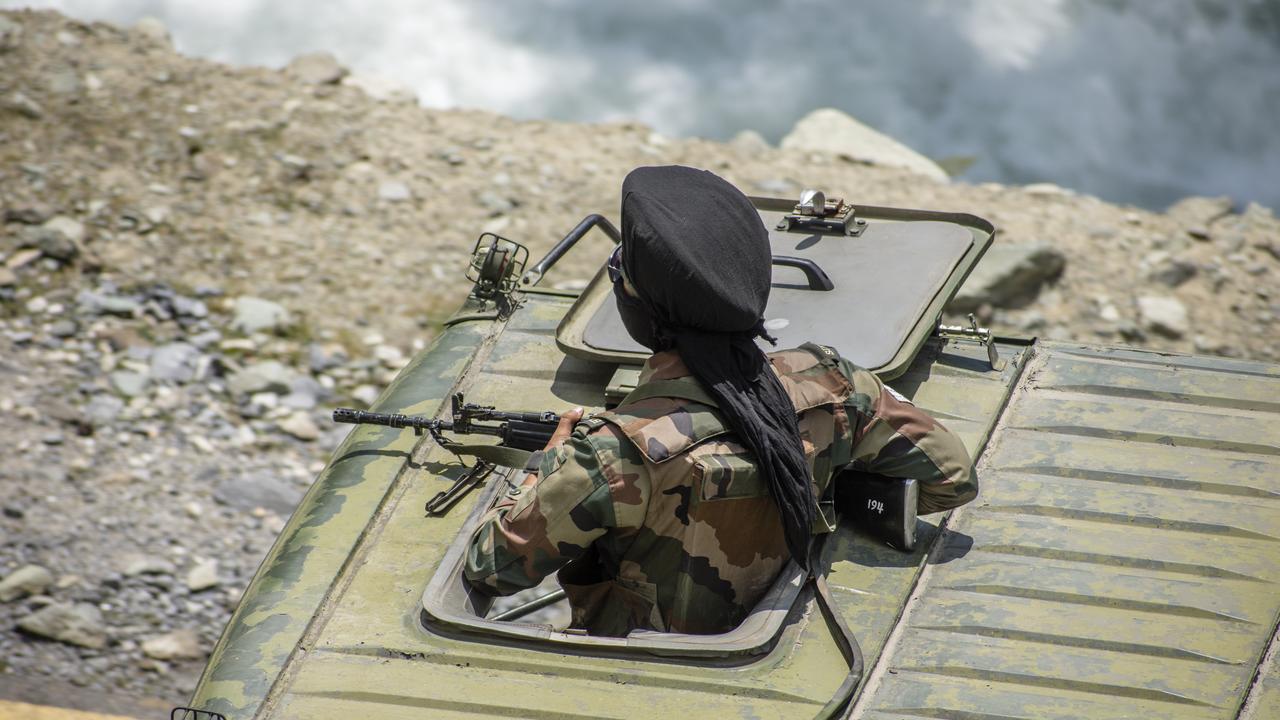India’s anger boils over as it prepares for conflict with China
After two years of a jittery peace, India has deployed 50,000 troops, convinced that a conflict with China is all but inevitable.
After two years of tense peace, hundreds of Chinese troops have encroached upon what India perceives to be its side of the border before being stopped in a battle involving branches, bricks and iron bars.
Now India’s in uproar, convinced a looming war with China is all but inevitable.
In June, Chinese Chairman Xi Jinping proclaimed to the world he wants to present a “credible, loveable and respectable China” and “expand its circle of friends”.
But, two-and-a-half years after a fatal clash between Indian and Chinese soldiers in the Galwan Valley, Ladakh, another brawl has erupted. This time it was over ownership of a remote, 5200m-high mountain peak at Yangtse, Tawang.
While 20 Indian and an unknown number of Chinese troops died in the 2020 clash, confused reports suggest this incident was less brutal – though “as many as 30” Indians may have been seriously injured.
The “physical scuffle” reportedly resulted when a Chinese patrol encountered an Indian garrison and attempted to force their way past using iron rods, spiked clubs and tasers. Firearms were avoided as this could have triggered an escalation of hostilities, including artillery and combat aircraft.
The location of clash is important. China has been repeatedly trying to take control of a 17,000 feet high peak.
— Ajay Banerjee (@ajaynewsman) December 13, 2022
So far India is firm control of peak.
👇Chinese location at the base of an approach route to the peak top. pic.twitter.com/zSRhU2Q2RW
The incident came as India’s parliament sat in New Delhi, triggering angry debate over “complacency”, “diplomatic failings” and “preparations for war”.
But military analysts are using the renewed fighting to highlight Beijing’s relentless build-up of military barracks, bases and artillery emplacements along the 3500km border. And the rapid construction of roads and bridges leading towards the disputed “Line of Actual Control”.
As a result, New Delhi isn’t feeling the love.

Some 50,000 Indian troops have now been deployed to the bitterly cold, thinly oxygenated, rugged terrain. More are taking up supporting positions.
“China has lost India,” Brookings Institute analyst Tanvi Madan says.
“India has long sought to maintain its strategic autonomy, refusing to be drawn into alliances. Now, however, it is at least aligning with countries to address the threat China poses.”
Actions speak louder than words
Chairman Xi told Communist Party officials in June that he wanted to see a change in their international dialogue.
“It is necessary to make friends, unite and win over the majority, and constantly expand the circle of friends in international public opinion,” he said.
China must be “open and confident, but also modest and humble”.
Beijing then called on New Delhi to put aside border disputes and restore diplomatic and economic ties. This seemed promising as the most recent border incidents – in 2013, 2014, 2015, 2017 and 2020 – had all been under Xi’s rule. No clashes had been recorded since the mid-1980s.
A visit by China’s foreign minister and record highs in bilateral trade appeared to suggest Beijing was good for its word.
But Xi reverted to his older, more belligerent messaging in October when he overturned the Communist Party’s constitution to secure a third term as “Great Helmsman”.
“The use of military power needs to be normalised and used in diverse ways,” he told the 20th Communist Party Congress. “We need to be able to stage military operations readily, create a secure environment, deter and control risks and conflicts, and win regional wars.”
1/3
— OsintTV📺 (@OsintTV) December 14, 2022
🚨Chinese media started reporting on Tawang clash:
Most of the news channels repeating the spokesperson statement
Sen Col Long Shaohua spokesperson for the Western Theater of the Chinese People's Liberation Army made a statement on our routine patrol in the Dongzhang area pic.twitter.com/CVsz5Bm0q2
Beijing has fought two regional wars and advocated for a third since the Communist Party took control in 1949.
It surged into Indian territory shortly after seizing control of Tibet in 1962. In 1979, an invasion force was repulsed by Vietnam. And Beijing has repeatedly asserted its intention to use military power to defeat the last standing outpost of the Republic of China, Taiwan.
But the ongoing military build-up near India has revived fears that this is one of the “regional wars” Xi now intends to win.

Precipitous peace
Beijing claims “traditional” ownership of the Indian state of Arunachal Pradesh. It calls it “South Tibet”. Whether or not it is “South Tibet”, Tibetans don’t believe Tibet belongs to China. It was annexed by Beijing’s troops in 1951.
In the 1962 war, China routed India’s unprepared forces to seize control of much of the region. Then, a few weeks later, it suddenly withdrew.
But, 60 years later, Beijing is showing interest once again.
“In addition to building its military muscle and connectivity infrastructure along the eastern sector, it has sought to strengthen its claims over territory here through a variety of measures, including providing Chinese names to 15 places in Arunachal,” The Diplomat’s South Asia analyst Dr Sudha Ramachandran says.
An undated video of a clash between Indian & Chinese soldiers being shared widely in the context of the Tawang incident. Not clear where or when this video is from, but clearly not from Dec 9 incident. Don't remember seeing it before though. OSINT/Experts? pic.twitter.com/aAKOeNlBBa
— Shiv Aroor (@ShivAroor) December 13, 2022
“Beijing has also strongly objected to Indian moves to improve its own infrastructure here. And visits by Indian leaders, the Dalai Lama, and US officials to Arunachal have evoked sharp criticism, even warnings from Beijing.”
This diplomatic posturing matches that applied to the contested islands of the East and South China Seas and Taiwan.
Senior Indian and Chinese commanders have met 16 times to discuss terms of disengagement and ease tensions in the contested areas since the fatal 2020 clash. But Beijing has refused to withdraw from the heights its troops seized in Depsang and Demchok.
The Changdu Bamda airport is undergoing a massive expansion to make it a dual use civil / military airport
— Viper (@viper202020) December 21, 2021
Additions include a 2nd runway and a large apron area typically used for parking military aircraft as seen in other #PLA bases#indiachinastandoff#osint#tibet#Chinapic.twitter.com/dzFwCRRaiZ
And Indian General Manoj Pande has confirmed China’s military infrastructure building is “going on unabated”, as satellite photos suggest. Now there’s been another violent clash. And Tawang had been relatively quiet.
“The perception of China as an adversarial and untrustworthy actor has, in turn, produced changes at the border that will likely outlast this crisis,” Madan says. “Both sides have beefed up their military presence at the border, with many more forward-deployed troops. The Line of Actual Control between Indian-held and Chinese-held territories now looks more like the heavily militarised Line of Control between India and Pakistan.”
Heights of tension
Tawang, the site of the most recent clash, has history. Chinese troops pushed through the nearby Bum La Pass to invade India in 1962. It is also home to the Tawang monastery – the most significant Tibetan Buddhist monastery outside the Potala Palace. The Dalai Lama sought refuge here in 1959 amid the Chinese assimilation of Tibet.
4) Reports suggest that in Yangtse, the Chinese target is a 17,000 ft peak which provides excellent views of the terrain on the Indian side, particularly the road connecting Tawang with the Se La Pass, the main supply line from the plains to the Tawang tract. pic.twitter.com/BeMLRAh155
— Indo-Pacific News - Geo-Politics & Military News (@IndoPac_Info) December 14, 2022
But analysts say the latest incident came days after joint US-Indian military exercises were concluded just 100km from the contested border.
“With its ingression at Tawang, Beijing has signalled yet again that there will be costs to the mounting India-US co-operation, especially in the Himalayan heights close to Tibet,” writes Ramachandran.

Such co-operation, Madan says, is the result of Xi’s actions contrasting so dramatically with his words.
“With its 2020 actions at the border, Beijing has stalled, if not reversed, years of deepening Sino-Indian ties,” she says. “It has also, counterproductively, facilitated the strengthening of Indian partnerships with many Chinese rivals.
Recent Satellite Image show deployment of #PLAAF Fighter Jets at Changdu Bangda Airport, Tibet.
— Mrcool (@Mrcool63040811) December 15, 2022
Previously it was a civilian airport but after the 2020 Standoff, it has been upgraded as a double purpose airport both for civilian and military. pic.twitter.com/o89mBhVbAl
“India is now willing to co-operate more closely with the United States, even at the risk of angering China.”
New Delhi signed an intelligence-sharing agreement with Washington in October 2020. It has increased its participation in the Quadrilateral Agreement with Australia, Japan and the United States. It has become more involved in regional naval exercises. And it has supplied missiles to help reinforce the Philippines’ claim over the Spratly Islands.
“India once tiptoed around China’s sensitivities regarding perceived threats to its sovereignty,” Madan says. “New Delhi is no longer being as deferential.”
Jamie Seidel is a freelance writer | @JamieSeidel






